
Choose a tripod
Let's start from a fundamental premise: there are many shooting techniques that would not be practicable without the help of a tripod. And that is why one cannot be missing from the photographic kit. But how to choose the right tripod?
Just to say, it's virtually impossible to take perfectly sharp long exposures without the proper support. This means that without a tripod it will not be easy to take night photographs or those classic landscapes in which the water looks like a silky mantle. And no creative lighting like light painting or, again, no photographs in particularly dark places without finding yourself having to fight with the excessive noise due to high ISOs that we will have to rely on.

These are just some of the examples, because without a tripod it will be difficult to have maximum sharpness even for architectural and naturalistic images. There are certainly other genres that I could mention to emphasize the importance of the tripod, but already in this way I have embraced the more classic situations in which you will need them.
And I also add that without the tripod we would never have been able to enjoy images of great landscape photographers and I will just mention one of them: A. Go take a look at her breathtaking views.
So far I have only talked about photography, but also in the video field the tripod is a very important accessory and it is fair to say that in general, for the realization of images, the tripod can be considered as one of the main protagonists.
How to choose the perfect tripod
What you need to know is that on the market there are all kinds and for every wallet, so it is first of all essential to be clear about the type of use you will make of them. For example, if you are planning to take it with you on a trip it is good that it is a compact and lightweight tripod not to regret your choice after a few minutes. Certainly you will need to find compromises, especially if your camera is heavy or if you plan to take pictures in notoriously windy places. In these cases, however much you may wish, a tripod that is too light will never be for you. And compromises must also be made thinking about the budget, because maybe you might find yourself in front of two identical tripods that differ only in the used materials. Maybe one is in aluminum, the other in carbon fiber. The first will weigh more and cost less, the second will certainly be lighter but also much more expensive.
Discount
 Manfrotto MKCOMPACTACN-BK Tripod with Bag, Hybrid Head ...
Manfrotto MKCOMPACTACN-BK Tripod with Bag, Hybrid Head ...
- Circular Quick Release Plate for a great setup
- Photo / video selector to change the mode
- Compact and easy to carry
If weight and dimensions are the first parameters to be based on, then there is the one linked to stability, which is perhaps the most important. A tripod should not transmit any vibration to the camera when shooting, otherwise the results will be affected. For this reason it is important to choose a tripod made of rigid materials and which has safe fixing systems.

Then there are further features to consider when choosing the right tripod for your needs, such as the central column, which allows us to reach greater heights and in some specific models even to be positioned horizontally. Another aspect to consider is the type of leg lock: there are lever mechanisms or screw ones. Personally I prefer the ones with the lever, with which it is much faster to prepare for the shot, as well as it takes much less time to close them.
Finally, to choose a tripod, we must also consider the forehead that we are going to mount on the legs. While it is possible, it is not common practice to use a tripod without the head. There are many types and once again the choice will be determined by the purpose: the most common are the ball heads, the 2 or 3-way heads, the rack ones or the fluid heads, suitable for the video sector.
Now that I have shown you what the characteristics are in general, let's try to understand how to choose the tripod that best suits your needs. The same is true that I have already done for cameras and lenses, there is no universal one.
Choosing a tripod: weight, size and height
As you may have already guessed, the first aspects to investigate before buying a tripod are weight, dimensions and even height. And I also add the weight it can support, because it is never that during a shot everything falls to the ground ending with the breaking of camera and lens! So, even before you worry about how much weight you will have to carry on your shoulders to get behind a tripod, make sure it can support the weight of your camera and your heaviest lens, maybe even a little more. Better to rest assured even when, without thinking too much, you will add more taken to the camera by leaning on the tripod. Or, who knows, maybe in the future you will add a flash or other accessory that will increase the overall weight, so better be sure right away that the tripod can support all of this.

As far as the 'heightInstead, the first useful tip - and I'm speaking from personal experience - is to choose a tripod that is tall enough that you don't have to bend over every time to look in the viewfinder or display. Except in particular situations it is, in fact, a good idea, when taking pictures, to have the viewfinder at the same height as our eyes. To give you general references, consider that, if you are buying a tripod without the head, the legs, once spread, reach more or less your shoulders. If, on the other hand, the head is already included, its highest point must reach approximately the height of your jaw. I know, however, that this aspect cannot always be part of the fundamental parameter of every purchase, the budget. As much as possible, try to choose a tripod that reaches at least 160cm.
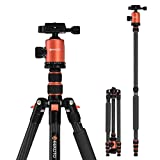 GEEKOTO Camera Tripod 200cm Carbon Fiber Tripod ...
GEEKOTO Camera Tripod 200cm Carbon Fiber Tripod ...
- New Generation Material: Made of pure 8-layer carbon fiber, the camera tripod offers a ...
- Flexible Position: 4-section column leg with twist lock for easy height adjustment and ...
- Multiple Utility: The removable leg with sponge can be unscrewed and work alone as a machine monopod ...
Speaking instead of minimum height, that is, when it will be folded back on itself, the factors to consider are linked above all to the space that you can dedicate to it to always carry it with you. And at the same time it shouldn't weigh too much otherwise I'm sure you won't take it so often on trips! Once again the cost factor comes into play, because choosing a light, sturdy and long-lasting tripod means opting for one made of carbon fiber. It is certainly the best material, but it is also the one that will make you spend the most. Heavier, more common and certainly cheaper are aluminum tripods. Finally, there are also steel ones, which are certainly solid, but too designed for use outside the studio. Indeed, they are usually suitable for video productions that involve the use of large video cameras.
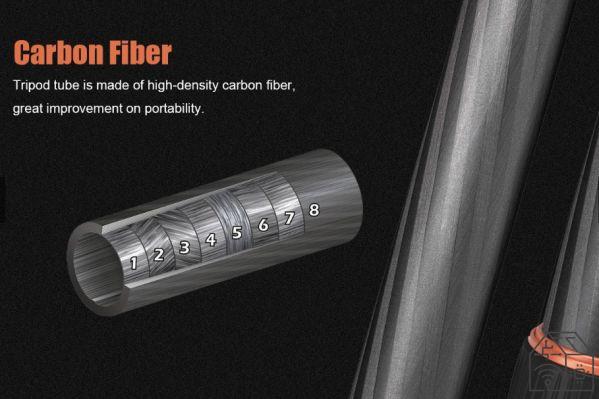
The overall weight can also determine the size of the legs, not just the material they are made of. The diameter varies according to how many sections they have and how much weight they can bear. To always carry a tripod with you I suggest you not to go beyond 2 / 2,5kg (those in carbon fiber, without considering the head, on average weigh about 1,5kg).
Tripod legs usually have 3 to 5 sections and obviously the more they are, the more the tripod can reach a greater height. But be careful, because the higher you go, the lower the stability. In the case of very high tripods, I suggest that you use a weight to attach under the central column to increase its stability. Almost all tripods are equipped with a hook, use it by attaching your backpack or camera bag. Sometimes the central column - in some cases even one of the legs - can be separated from the rest of the tripod becoming a monopiede. It is certainly used on fewer occasions, but it is worth choosing a tripod that also gives us this possibility, you never know.

Some tripods also offer the possibility to change the feet, so you can choose the ones that best suit the type of terrain in which you are photographing. Others, on the other hand, have screw systems from which a tip comes out to better secure the tripod on slippery ground.
How to choose a tripod: the first purchase
If you have recently approached photography, it is possible that you have opted for a camera that is not too bulky, such as a mirrorless or an entry-level SLR. If this is your case, you can definitely opt for light tripods (even less than 1kg) because it will still be able to hold your camera. The family Manfrotto Compact, for example, it offers several products that are sure to be right for you. They are light, easily transportable and able to support and keep stable up to about 3kg overall between camera and lens. We are therefore also talking about mid-range SLRs with a standard lens. Here, do not think you can mount who knows what telephoto lens, but to start it could be a fairly cheap choice (prices are all under 100 euros).

If you want to spend less you can also take a look at other brands, such as Sirui, Cullmann or simply Amazon Basic. To get started with long exposures, night photography or genres that require the use of a tripod, it is not necessary to spend a lot, even if you will carry a good tripod with you for many years. Considering that over time you could change your camera, add heavier lenses than you currently have, maybe photograph in the rain or in other adverse situations, if you have the opportunity, immediately think about a higher level tripod.
The travel tripod
If you want to travel with your trusty tripod in tow, make sure it fits in your suitcase! This is the only real discriminant. Pay attention to the minimum size and choose something with space saving solutions like what the offers Benro Travel Slim. It is a tripod that when closed takes up less space than many others because by folding in on itself, the head will be closed between the legs.
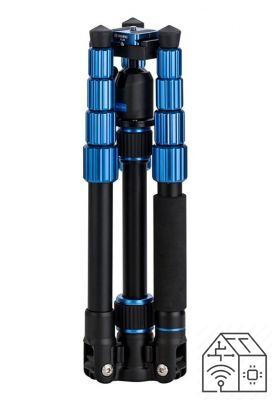
Keep in mind that given the small size it is unlikely that a travel tripod will be very tall, will have many sections to contain the dimensions and probably will be made of carbon fiber to minimize the weight. Basically a good travel tripod will cost. In fact, the perfect travel tripod has to be the cideal omnube between portability and lightness, without forgetting the aspect of stability. This does not mean that there are no less expensive aluminum ones, but precisely because you want to always carry it with you maybe it is worth making a bigger investment. The Manfrotto Befree line is among the best-selling ever and there are several models, take a look there too.
Among the travel tripods I insert a sub-category, that of the so-called table tripods. These are small tripods that take up very little space and that we can really take with us at all times. They fit easily in a bag or backpack, but maybe even in your jacket pocket. The best known of these are those of the Joby family, i gorilla pod. And don't think that they are not stable or that they cannot hold your camera, because there are models that can support up to 5kg!
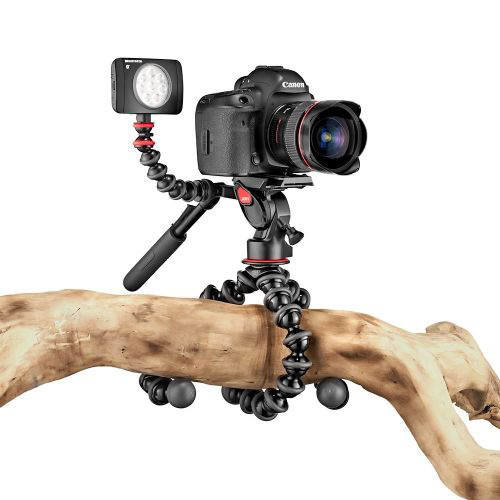
So if you want to travel as light as possible, a solution like that of the Gorillpods could really be for you. They can also be easily attached to multiple supports due to their structure.
The choice is among many possible options, remember to choose something comfortable, which does not hinder you when you are not using it, but which is also sufficiently resistant.
Choose a tripod: better performance
Tripods can cost a lot, but what changes with the lower-end models? A tripod is not just a three-legged structure on which to mount the camera, a tripod must be a faithful work companion. It is definitely not necessary to spend up to 1500 euros for a tripod and a head Gitzo - probably the best you can find - because both Manfrotto and Benro, for example, can offer what even the professional needs. Manfrotto's 055 line costs just over 500 euros (list price) to which a suitable head will be added, but there are many professionals who use it. And if you look hard you may find some really inviting offers so it makes sense to invest in a tripod that will last a long time, like the one currently in place on Amazon for which you can find the 3-section version for only 200 €.
 Manfrotto 3 Section Tripod Kit with 3 Axis Head in ...
Manfrotto 3 Section Tripod Kit with 3 Axis Head in ...
- PROFESSIONAL: The kit includes a 3-section tripod and a Pro head with quick release plate; a complete kit and ...
- VERSATILE: Thanks to the 90 ° column the tripod can switch from vertical to horizontal orientation, without ...
- SAFE: Thanks to the Quick Lock locking system, which opens the tripod legs in one movement and controls ...
The higher you go in a manufacturer's range, the more we find finishes, details and anything else designed to offer maximum stability and comfort. High-end tripods can be used both in the studio and in the field, they are often equipped with a central column that can also extend horizontally, useful for macro and food photography. Or again, they can allow you to mount photographic and video accessories on a dedicated arm or support, in short, they can be modular. We can find integrated small useful accessories, such as a bubble, useful for having perfectly straight horizons.

If you are looking for a studio tripod, however, the precautions to follow before choosing the right tripod are certainly less. We will no longer need lightness and therefore we will not need carbon fiber since we do not have to carry it from one location to another. We will need something absolutely stable and can be easily adjusted. The choice of a tripod with a central rack column is indicated, because it allows a precise adjustment of the height even with a lot of weight on the head. For studio tripods it is a good idea to choose one with a central support system, which however can be activated both symmetrically and asymmetrically. What does it mean? It means that we can easily adjust the angle of the legs and wanting to choose different angles for each leg. It is a versatile and at the same time very safe system, able to offer maximum stability in any position.
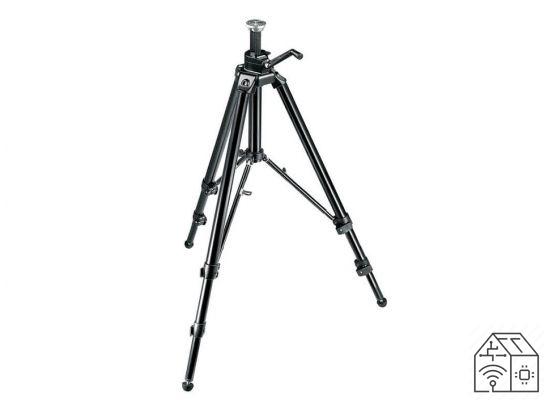
Choose a tripod: the head
The head to match is also fundamental in choosing a tripod. Again there are several possibilities including fishing, ball, three-way, panoramic heads or fluid heads for video. They vary not only in type, but also in size, price - there are from a few tens of euros to over 1000 euros. As for tripods, the cost varies according to the materials used, the ability to last over time and the systems that a head uses.

The best way to start is to try a simple one ball head, able to adapt to many photographic genres and easy to use. A single locking system to position the camera exactly as you prefer. For greater control, however, there are 3-way heads, those that have a lever for each movement. I recommend this system especially for those who work in the studio, who have time to maneuver three different levers to adjust the lateral inclination and the one up and down. Furthermore, the three-way heads take up more space than the ball heads, so even for a matter of size they are not practical to always carry around.
Discount Manfrotto MHXPRO-BHQ2 Xpro Ball Head, Black / Anthracite
Manfrotto MHXPRO-BHQ2 Xpro Ball Head, Black / Anthracite
- The magnesium alloy body and hollow ball allow for high load performance
- The triple locking system ensures the stability of the camera
- Ball heads are great for frequent camera position changes
If ball and three-way heads are the most common, architecture photographers will love those panoramic, which allow micrometric adjustments. Thanks to this system we can make sequences of photographs at precise distances and then be joined in post-production. We still talk about extreme precision even the rack heads, suitable for studio photography, but also for landscape or architectural photography. With this type of heads we can study the composition down to the millimeter and thus obtain the perfect alignment of the camera.

Instead, what you see above is one fluid head. These particular tripod heads are suitable for the video sector. Using them once will already make you realize how fluid the shots can be in the movements. The clutch systems that characterize these heads allow you to adjust the speed of the movements. With this type of head it is also very important to have a quick release system, so that we can take the camera quickly if we were to continue with hand-held shooting. Having opened the parenthesis on the release system, I take the opportunity to spend a few words on this last topic as well.
Each head uses its own system to lock the camera and the only suggestion I want to give you is to be careful to choose a head that has a system of quick release. A lot of heads, unfortunately, have systems that force you to look for a coin or something similar to unscrew the plate from the camera and to be honest that's something I hate. In fact, there are systems that are just as safe but definitely more comfortable and quick.
Choosing a tripod: conclusions
Choosing a camera can be difficult, deciding which lens to match it too, but making a decision on which tripod to buy is perhaps even more complicated! There are so many small differences between one model and another that they are almost not perceived. If not for the cost. Choosing a tripod must always be done with certain aspects in mind. First of all, the intended use. If it is not clear to you what exactly you want to buy a tripod for, you will hardly find the right one. And by intended use I mean the places and photographic genres for which you will need the tripod. It is essential to know how much the equipment that you are going to use on the tripod weighs to avoid buying one that is not able to support that weight. And finally, we have to choose the head that is most suitable not only for the tripod, but also for your photography.
And remember that a tripod is essential in low light conditions, but it's also an incredibly useful accessory for expressing all your creativity.
Bestseller no. 1 Amazon Basics - Lightweight Camera Tripod with ...
Amazon Basics - Lightweight Camera Tripod with ...
- Height-adjustable tripod in lightweight aluminum; weighs just over 450g
- Movable and adjustable head in 3 positions; vertical or horizontal option
- Quick release plate to facilitate quick transitions from shot to shot
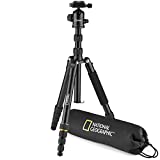 National Geographic NGTR002T - Travel Kit Treppiede con...
National Geographic NGTR002T - Travel Kit Treppiede con...
- The IDEAL TRAVEL COMPANION: the National Geographic Travel tripod kit is a complete, light and compact solution ...
- To FACE THE MOST DIFFICULT CONDITIONS without EFFORT: with the triple angle of the 5-section legs and the ...
- COMPACT and SOLID: From compact cameras to zoom DSLRs, the model supports up to 8kg of weight across ...


























